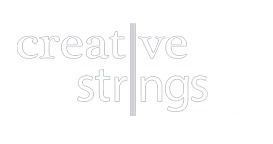Don’t be fooled by the suits…
Featuring Cedric Easton on drums and Greg Byers on bass; Recorded live at the Music For All Summer Symposium
Rock Improvisation – A Commentary
For players, students, teachers and anyone else interested—here are my thoughts on improvising a rocking electric violin solo.
1) Sound
Rock ‘n roll sounds better with distortion. Trying different types of distortion, amounts of gain, and the best EQ for each room requires effort, but nothing conveys rock like overdrive. Add delay, reverb, and wah, and you’re good to go. (See the Electric Violin Training Kit for an overview of amplified strings gear and how to use it.)
2) Harmony: How to create drama over a one-chord vamp
The harmonic structure given behind this solo is simply an E pedal vamp. Not E major, E minor, E7, or any specific chord—just open on E. Since there’s no other chordal instrument getting in my way, I can fill the open space with a new harmonic progression over the E pedal by alternating various modes (including E mixolydian, E diminished, B diminished, A harmonic minor, E minor pentatonic, and E Phrygian). Switching between different modes adds or releases harmonic tension. (For more on modes, access my instructional library at Creative Strings Academy.)
Instead of envisioning modes as scales or key signatures, one can also outline triads and seventh chords from any scale. Alternating between two arpeggios could be called a “chord pair”. I recommend starting out with chord pairs by alternating the tonic with some form of dominant chord. In the context of this solo, you could designate E minor 7 as a tonic and follow it with either the dominant/5 chord (B7), or an alternate to the dominant such as 4 (A), 4minor (A minor), flat 7 (D), flat 2 (F), flat 6 (C), 1 diminished (E dim), etc.. This implies a recurring progression between E and any other chord. By holding each chord for longer or shorter durations, one can use harmonic rhythm to manipulate tension and release.
In other words, you can leave the tonic chord to play any other collection of notes, and then come back to the tonic, over and over again. Or you can create a new chord progression that stays away from the tonic for a while and moves around a bunch of other chords before resolving. The point is to be aware of your harmonic intention, familiarize yourself with conventional choices, and try different combinations. (For more on chord pairs and harmonic tension, try my Harmony Fundamentals Series)
3) Rhythm: Keep it simple. Stay in the pocket.
When it comes to music with a strong groove, I try to play lines that fall clearly in the rhythmic grid. This creates cohesion. I suggest you record yourself improvising and keep score based on how often your lines get lazy, ambiguous, or rubato-sounding. If your rhythm is unclear, chances are you’re trying to play too much. As Victor Wooten writes in his book, The Music Lesson, “never lose the groove in order to find a note”.
4) Melodic shapes and phrases: Repetition vs. Randomness
I like to think about the general shape of a melody. It doesn’t have to be exact. Once I have a general shape in mind, I can play around with repeating, transposing, compressing, expanding, or inverting it. Another strategy I use is avoiding repetition to approximate randomness. I recommend structuring your improvisation using repetition and randomness, applying both ideas to shapes, melodies, and phrases.
Other alarm bells that run like a tape loop in my head include: when a phrase starts, how long a phrase lasts, how many notes are contained in a phrase, and how a phrase ends. Phrase endings are important. I like to make the endings of phrases clear and concise. Sometimes I interrupt phrases, forcing myself to play shorter ideas. Other times I keep a phrase going without spaces, relying on groove or attitude to push the music forward and sustain energy. (Apply these concepts with my Free Improvisation Master Series)
5) Attitude

In the end, it’s all about attitude. Sometimes I like to hold onto a feeling, focus on it, and try to channel it in my playing. For example, this photo reflects the feeling I had on stage. Improvisation provided an outlet to express it in that moment.
Gear supplied by the Electric Violin Shop
- Yamaha SV 250
- D’Addario Strings (Helicore and Zyex) and Planet Waves cables.
- Boss ME-50 effects
- Fishman Loudbox Amp
Learn more about online training, summer conference, and school outreach programs at christianhowes.com/education
Please like and share, and comment below for further discussion
Contact me at chris@christianhowes.com
Christian Howes is a Resonance Records recording artist. Support for this case study is provided by the Greater Columbus Arts Council and city of Columbus.


